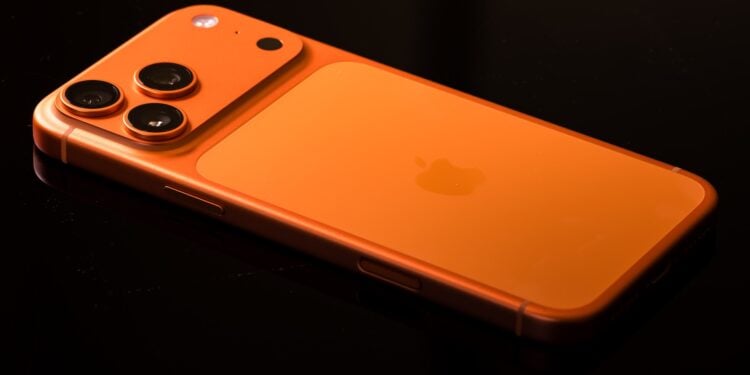The iPhone 17 Pro is here – with a redesigned design, new materials, and an improved finish. This year, Apple is opting for aluminum instead of titanium and promises greater robustness thanks to a special anodizing process. However, initial indications from Apple Stores and independent tests show that the iPhone 17 Pro isn't equally durable across the board. One area, in particular, stands out.
Apple is presenting the iPhone 17 Pro as a high-end device with a durable shell and a high-quality finish. The new aluminum casing is supposed to be not only lighter but also offer better scratch protection. However, the first signs of wear are already visible in Apple Stores – especially around the MagSafe charging area. At the same time, a well-known YouTuber is delivering completely different results with a standardized scratch test. This raises the question: Where is the iPhone 17 Pro truly sensitive – and where is it overdone?
New material: aluminum instead of titanium
The iPhone 17 Pro's casing is made of anodized aluminum for the first time. The anodizing process creates a hard, colored surface that Apple says is particularly durable. The coating's hardness is reminiscent of sapphire crystal. It's firmly bonded to the metal and protects the device from many typical everyday scratches. At the same time, the change in material makes the device appear lighter and more elegant. In contrast, Apple uses a titanium coating on the iPhone Air, applied via physical vapor deposition (PVD). This thin layer of colored titanium looks high-quality but could be more susceptible to wear—at least, that's what initial observations in Apple Stores suggest.
Scratches in Apple Stores: MagSafe Zone in Focus
In several Apple Stores, iPhone 17 Pro and iPhone Air display units exhibit significant scratches around the MagSafe module. These devices are touched and handled by countless people every day—and are also firmly attached to metal charging stations. The damage suggests that friction between the charging cradle and the case caused the scratches. Whether these scratches also occur under everyday conditions remains questionable.
Independent scratch test shows different result
YouTuber JerryRigEverything subjected the iPhone 17 Pro to a classic scratch test. This involves using standardized tools to determine how susceptible the surface is to different degrees of hardness. The result: The anodized aluminum casing resists minor scratches surprisingly well. Keys, coins, or other items in your pocket don't cause any significant damage to the back, sides, or around the MagSafe module.
- Particularly striking: The MagSafe zone, which is often damaged in Apple Stores, proved to be very robust in the test. This suggests that the scratches in the stores are not caused by the MagSafe itself, but rather by contact with the charging stand.
Camera module vulnerability
A real weak point, however, appears in a completely different place: the camera module. The camera unit of the iPhone 17 Pro is surrounded by a raised aluminum frame. This edge is sharp and not beveled. This is precisely where the anodized coating adheres less well than to the rest of the case. In testing, even simple objects like keys could leave visible scratches in this area. The combination of the raised position, sharp edge, and thin coating makes the camera module the most vulnerable part of the entire device. Anyone who frequently uses the iPhone 17 Pro without a case or carries it in bags with other items will likely notice signs of wear there sooner or later.
Thin coating – robust look, but limited depth
Another aspect is the thickness of the anodizing process. This coating is relatively thin and primarily protects against superficial scratches. Impacts or more severe impacts can damage the coating, revealing the underlying aluminum. This affects not only the camera module, but theoretically every edge and corner of the device.
Differences to the iPhone Air
While the iPhone 17 Pro uses anodized aluminum, the iPhone Air relies on a titanium PVD coating. The scratches on iPhone Air models in stores could also be due to the metal charging cradles. Whether the PVD process performs better or worse in everyday use is still unclear – systematic tests are lacking so far. What is certain is that both models show scratches under certain conditions – but in different places and for different reasons.
iPhone 17 Pro: Scratch-resistant with a clearly defined weak point
The iPhone 17 Pro is well protected against scratches in everyday use – especially thanks to its durable anodized finish. The frequently suspected weak spot around the MagSafe module is unproblematic according to tests. The real Achilles heel is the camera area. The sharp-edged protrusion with a weaker coating is prone to scratches and signs of wear. Those who value a flawless device should consider a protective case – especially to protect the camera. The rest of the device remains relatively robust in everyday use, as long as there are no drops or hard impacts. Overall, the iPhone 17 Pro makes a robust impression – with one small but important exception. The best products for you: Our Amazon storefront offers a wide selection of accessories, including those for HomeKit. (Image: Shutterstock / RYO Alexandre)
- iOS 26.1 Beta 1: All new features at a glance
- iPhone Air and iPhone 17 Pro: Bend & Drop Test Comparison
- New content for Apple Arcade: Highlights in October 2025
- Apple is working on new security features for iOS 26
- Apple in focus: EU investigates App Store over fraudulent apps
- Apple invests in redwood forest restoration
- Apple celebrates reopening of Ginza Store in Tokyo
- FiDA Regulation: Germany wants to exclude Apple & Co.
- Apple expands Image Playground – what the beta version shows
- Apple develops MCP integration for AI agents in iOS & macOS
- iOS 26.1: Language update for Apple Intelligence and AirPods
- Wedbush raises price target: iPhone 17 gives Apple investors hope
- Apple announces new immersive content for Apple Vision Pro
- iPhone 17: Users report Wi-Fi outages





